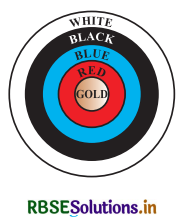RBSE Solutions for Class 10 Maths Chapter 12 Areas Related to Circles Ex 12.1
Rajasthan Board RBSE Solutions for Class 10 Maths Chapter 12 Areas Related to Circles Ex 12.1 Textbook Exercise Questions and Answers.
RBSE Class 10 Maths Solutions Chapter 12 Areas Related to Circles Ex 12.1
Unless stated otherwise, use π = \(\frac {22}{7}\).
Question 1.
The radii of two circles are 19 cm. and 9 cm. respectively. Find the radius of the circle which has a circumference equal to the sum of the circumferences of the two circles.
Solution:
According to the question,
Radius of the first circle (r1) = 19 cm.
and Radius of the second circle (r2) = 9 cm.
Let the radius of the third circle = R cm.
According to the question,
Circumference of the first circle + circumference of the second circle = circumference of die third circle
⇒ 2πr1 + 2πr2 = 2πR
⇒ 2π [r1 + r2] = 2πR
⇒ r1 + r2 = R
⇒ 19 + 9 = R
⇒ R = 28
Hence the radius of the circle (R) = 28 cm.

Question 2.
The radii of the two circles are 8 cm and 6 cm respectively. Find the radius of the circle having area equal to the sum of the areas of the two circles.
Solution:
Let radius of the first circle (r1) = 8 cm.
radius of the second circle (r2) = 6 cm.
radius of the third circle = R cm.
According to the question,
Area of the third circle = Area of the first circle + Area of the second circle
⇒ πR2 = \(\pi r_{1}^{2}+\pi r_{2}^{2}\)
⇒ πR2 = π \(\left[r_{1}^{2}+r_{2}^{2}\right]\)
⇒ R2 = (8)2 + (6)2
⇒ R = \(\sqrt{64+36}\) = √100
⇒ R = 10 cm.
Hence the radius of the required circle (R) = 10 cm.
Question 3.
In fig. depicts an archery target marked with its five scoring areas from the centre outwards as Gold, Red, Blue, Black, and White. The diameter of the region representing the Gold score is 21 cm and each of the other bands is 10.5 cm wide. Find the area of each of the five scoring regions.

Solution:
According to the question Diameter of gold region = 21 cm
Radius of gold region (R1) = \(\frac {21}{2}\) = 10.5 cm.
∴ Area of gold region = \(\pi R_{1}^{2}\)
= \(\frac{22}{7} \times \frac{21}{2} \times \frac{21}{2}\)
= \(\frac {693}{2}\) cm2
= 346.5 cm2
Area of red region = π[(21)2 - (10.5)2]
= \(\frac {22}{7}\) (441 - 110.25) cm2

Question 4.
The wheels of a car are of diameter 80 cm each. How many complete revolutions does each wheel make in 10 minutes when the car is travelling at a speed of 66 km per hour?
Solution:
According to the question,
Diameter of the wheel = 80 cm.
∴ Radius of the wheel (R) = 40 cm = \(\frac {4}{100}\) = 0.04 m
Hence, circumference of the wheel = 2πr
= 2 × \(\frac {22}{7}\) × 0.04
Let each wheel make n complete revolution in 10 minutes.
∴ Distance covered in a complete revolution = \(n\left[0.8 \times \frac{22}{7}\right]\)
Speed of car = 66 km/hr
Distance covered in 60 minutes = 66 km = 66 × 1000 m
∴ Distance covered in 10 minutes = \(\frac{66 \times 1000}{60} \times 10\)
∴ \(n\left[\frac{22}{7} \times 0.8\right]\) = 11000
⇒ n = \(\frac{11000}{0.8} \times \frac{7}{22}\)
⇒ n = 4375
Hence the number of complete revolutions made by each wheel in 10 minutes = 4375

Question 5.
Tick the correct answer in the following and justify your choice:
If the perimeter and the area of a circle are numerically equal, then the radius of the circle is-
(A) 2 units
(B) π units
(C) 4 units
(D) 7 units
Solution:
Circumference of circle = Area of circle
⇒ 2πR = πR2
⇒ 2R = R2
⇒ R = 2
∴ Correct choice = (A).
